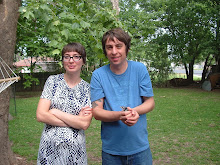The Micro-Farm has shown an impressive display of snails this Spring. The heavy rains and super-sized Hairy Vetch ground cover, provided a wonderful breeding ground and all you can eat buffet. The first rainy evening of the snail invasion, I counted ten Chocolate-Banded Snails within a four or five square foot area. I was in awe of these tiny garden creatures, as they munched away on last years rotten pepper plants and fading Hairy Vetch tendrils. These were the preferred mollusks of my childhood. They rated right up there with the ditch tadpoles that I collected in Mason jars in order to witness their toad-let transformation up close.
My admiration of the little beasts faded after only a few days. It was time to put the seedlings into the ground- Marigolds, Calendulas, Morning Glorys, and a few nameless others that had lost their haphazard labels. Most of my little seedlings didn’t last more than a week. Every morning, I’d find two or three more sprouts taken by the snails. I didn’t understand it- I had the seedling trays right next to where I planted them and before the seedlings were in the ground, the snails didn't touch them. I had even seen snails and snail trails in the seedling trays, but they didn’t seem to want to eat the seedlings until the plants were in the ground. Well, in all fairness, I cannot solely blame the snails. My kitties were also responsible for ten seedling deaths. As soon as dirt went into the raised beds, the kitties claimed them as camouflaged hunting grounds and litter boxes. Where I planted the Calendulas- the cats repeatedly dug them up until dead. I now have a handy collection of sticks to shove in the ground to create a fortress around my next set of sprouts.
Snails don't have ears but instead use their bottom set of tentacles
to pick up sound vibrations in the air.
I didn’t have the heart to kill any of the snails at the Micro Farm. In fact, while I was taking pictures of them, I accidently crushed one and I felt absolutely horrible. I did, however, research future tactics in snail/slug control. Next Spring, I will be armed with barriers to protect my new seedlings such as: coffee, eggshells, sawdust, or fine coarse rock. Strips of foil and copper could also be used. There are two theories on copper. Either copper carries a charge that the snails don’t like and they are repelled by it, and/or it oxidizes into several types of salts, which dehydrate the snails.
Of course, there are also plants that I could interplant the seedlings with. Plants that may repel snails and slugs include:
- Garlic
- Lavender
- Wormwood
- Thymes
- Sage
- Stinging nettles
- Borage- Shown on left
- Older marrows, squash or cucumber
- Geraniums
- Mint
- Lemon balm
- Tansy
- Hyssop

There is also the predator route of snail control- hedgehogs, large frogs, centipedes, blue jays, owls, ducks, nematodes (Heterorhabditis marelatus), and my vary favorite slug and snail eater – CHICKENS.
Isis the Hen
My chickens ate the snail I accidently crushed, but I couldn’t bring myself to just pluck the snails off one by one and send them to their death by ravenous hens.
I did a little searching on escargot. It seems that snail farming could have been an easy personal side project if it wasn’t for this upcoming drought Central Texas is entering in to again. The Chocolate-Banded Snail, Eobania vermiculata lives in Central and Southestern Texas and is related to the Garden snail- both can be used for escargot. There are tight state regulations on snail production and a limited Texas market, and I don’t think I could eat something that I’ve raised (even a snail). I thought of having a whole snail set up in a box just to watch them- like my tadpoles. I’d keep the snail box next to my worm box.
Snails have primitive eyes (referred to as 'eyespots') that are located on the tips of their upper, longer pair of tentacles. Snails don't see in the same way we do. Their eyes are less complex and provide them with a general sense of light and dark in their surroundings. The short tentacles located on a snail's head are very sensitive to touch sensations and are used to help the snail build a picture of its environment based on feeling nearby objects.












